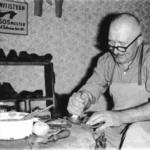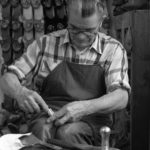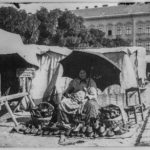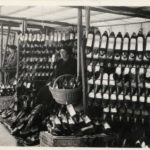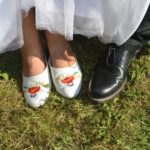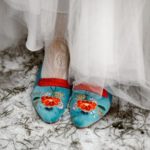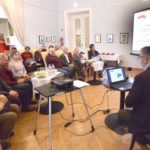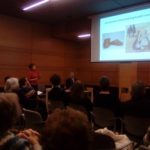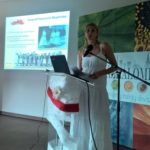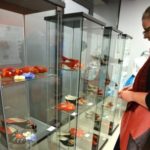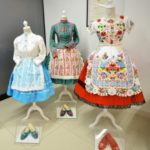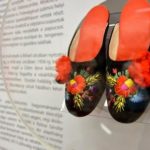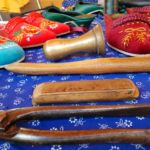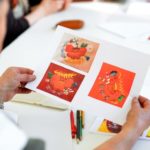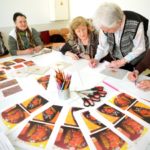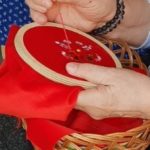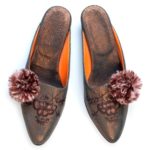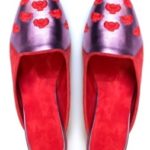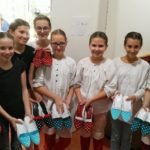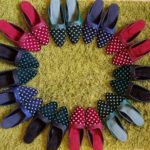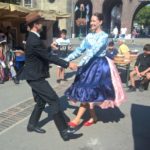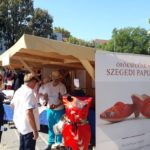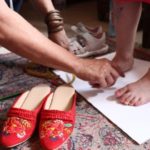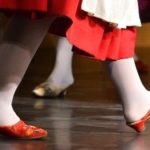FOUNDATION FOR THE SZEGED MULE SLIDES
HISTORY
Making and wearing babouche-style mules dates back to the times of Hungary’s Turkish occupation. The shape and style of this footwear and the hand-sewing technique have been passed down and preserved through the generations almost unchanged. These kitten-heeled velvet mules are distinguished by their poppy, cornflower and ear-of-wheat embroidery. The people of the region wore such slip-shoes, handmade by Szeged masters, on both weekdays and festive occasions. In the first decades of the 20th century, Szeged still had 50 to 80 craftsmen who sold their floral mules in national markets in about 6 or 8 counties. Their exquisite footwear was not only popular at numerous local and national trade fairs, but also found their way to the world exhibitions held in Paris and Brussels.
The people of Szeged still wear the white bridal mule with the wedding gown and the red mule for the new wife’s dance; Hungarians living abroad purchase them as a symbol; and numerous mules clack on folk dancers’ feet in Hungary and all over the world.
PRESENT
Today only a few are left who still know how to make traditional mules, and hand-sewn mules are no longer made in Szeged. In the entire country there are but a couple of workshops left, and even the showroom established in the last traditional master’s former shop has been closed. Nevertheless, the tradition of wearing mule slides has not completely died out, it is still part of life in the Southern Great Plain Region. If we want to prevent its extinction, this is the time to act. The Foundation for the Szeged Mule Slides has been established to maintain the several hundreds of years old tradition and to popularize it. We collect old mules, repair and recondition them, donate them to various public collections and showcase the most beautiful pieces at seasonal exhibitions. We hold conferences and make presentations about the past, present and future opportunities of these mules.
menyasszonyi papucsok (2000-es évek)
konferenciák, kiállítások
TRANSFER
The board of trustees of our Foundation, Dr Ildikó Bárkényi, Dr László Felföldi and Csaba Szögi, also make efforts to retain knowledge, since with the last active maker of handcrafted mules the tradition will vanish. This nice footwear is the product of cooperation: heels are made by turners and the velvet upper mule is made to measure before it is embroidered. Looking for one-off, handcrafted and local items is a general trend all over the world. We hope that making Szeged mule slides will provide a living for several people and so we would like to facilitate training young replacement. In order to ensure succession in this profession, our Foundation will launch teaching mule embroidery and mule-making. In addition to the currently active specialists, we have invited elderly embroideresses and mule-makers to teach.
Applied folk artist Mrs Ferenc Fetter teaches mule embroidery
INNOVATION
In addition to the traditional style, it is important to “reconsider” the slide and make it available in a new and modern form to attract fashion-minded young people. We aim to support innovation and win young applied artists and fashion designers to rethink the Szeged mule slide. We have already organized a conference on new mule-making techniques and innovative opportunities. The modern collection was displayed next to the traditional mules at an exhibition. With their collection designer Zita Attalai and master shoemaker Tibor Sallay aim to make footwear based on the Hungarian traditional motifs attractive for the followers of fashion.
Zita Attalai and Tibor Sallay with reconsidered mules
HERITAGE
The token of handing down a craft and the survival of the tradition is addressing children. We are inviting primary-school pupils to a summer camp where they can learn the basics of mule-making and embroidery, dancing in mules and the traditions surrounding this mule in folk tales, folk songs and stories. In the camp art curator teachers, drama teachers, folk dance teachers, folklorists and master craftsmen will run the activities. We hope that some of the children will take a liking to this craft and make it profession.
gyermekpapucsok
POPULARIZATION
Our foundation would like to have an increasing number of people consider wearing these mules as a symbol of belonging to a smaller or larger community. These mules were already in the focus of the Ball of Traditional Fashions; at the Summerfest International Folklore Festival the first conference about these mules was organized; the Szeged Mule Slides Award was revived at the Szeged International Folk Dance Festival and we organized the Day of the Szeged Mule Slides in the Agora of Szeged. In concert with the Association of Hungarian Folk Artists, in a call for tenders we invited craftsmen and designers to reconsider the Szeged mule. In 2019, visitors to the four-day Festival of Folk Arts, organized in the Castle of Buda, will be able to watch mule-making for the first time ever in a demonstration workshop and study the craft at an exhibition.
For the programmes of the Foundation for the Szeged Mule Slides and their dates, please visit our website.
www.szegedipapucs.info
rendezvények, események, bemutatók
In 2005 the city of Szeged established protection for the velvet mule with a leather sole. In 2013 the craft of mule-making was included in the collection of traditional values of Szeged and in 2014 in that of Csongrád County, and since 2015 it has been listed among the OUTSTANDING NATIONAL VALUE among the cultural heritages listed in the Collection of Hungarian Values. With the unanimous vote of the National Committee for Intangible Cultural Heritage Hungarian National Commission for UNESCO, in 2018 the “Live tradition of making and wearing Szeged mule slides” was included in the National Inventory of Intangible Cultural Heritage.
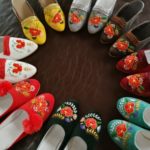
The following partners and supporters helped us in the implementation of our work and achievement of our plans:
Hungarian Heritage House, Budapest
Hungarikum Commission
MASZK Association, Szeged
Hungarian Ministry of Agriculture
Moholy-Nagy University of Art and Design, Budapest
Móra Ferenc Museum, Szeged
Association of Folk Artists
Somogyi Károly City and County Library, Szeged
Summerfest International Folklore Festival, Százhalombatta
Szeged Dance Ensemble
Szeged International Folk Dance Festival
Foundation for Szeged
Szent-Györgyi Albert Agóra, Szeged
and photographers Aurél Iványi and Yvette Frank
Photos: MTI, Fortepan, Móra Ferenc Museum, Szeged.hu, nlcafe.hu, Tibor Mester, Tamás Urbán, Lajos Kovács jr., Csaba Szögi, Péter Rózsa, Géza Hernád and various family archives

